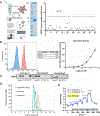The human CD47 checkpoint is targeted by an immunosuppressive Aedes aegypti salivary factor to enhance arboviral skin infectivity
- PMID: 39121194
- PMCID: PMC11924945
- DOI: 10.1126/sciimmunol.adk9872
The human CD47 checkpoint is targeted by an immunosuppressive Aedes aegypti salivary factor to enhance arboviral skin infectivity
Abstract
The Aedes aegypti mosquito is a vector of many infectious agents, including flaviviruses such as Zika virus. Components of mosquito saliva have pleomorphic effects on the vertebrate host to enhance blood feeding, and these changes also create a favorable niche for pathogen replication and dissemination. Here, we demonstrate that human CD47, which is known to be involved in various immune processes, interacts with a 34-kilodalton mosquito salivary protein named Nest1. Nest1 is up-regulated in blood-fed female A. aegypti and facilitates Zika virus dissemination in human skin explants. Nest1 has a stronger affinity for CD47 than its natural ligand, signal regulatory protein α, competing for binding at the same interface. The interaction between Nest1 with CD47 suppresses phagocytosis by human macrophages and inhibits proinflammatory responses by white blood cells, thereby suppressing antiviral responses in the skin. This interaction elucidates how an arthropod protein alters the human response to promote arbovirus infectivity.
Conflict of interest statement
Figures






References
-
- Caraballo H, King K, Emergency department management of mosquito-borne illness: Malaria, dengue, and West Nile virus. Emerg. Med. Pract. 16, 1–23 (2014). - PubMed
-
- Barillas-Mury C, Ribeiro JMC, Valenzuela JG, Understanding pathogen survival and transmission by arthropod vectors to prevent human disease. Science 377, eabc2757 (2022). - PubMed
Publication types
MeSH terms
Substances
Grants and funding
LinkOut - more resources
Full Text Sources
Medical
Molecular Biology Databases
Research Materials

